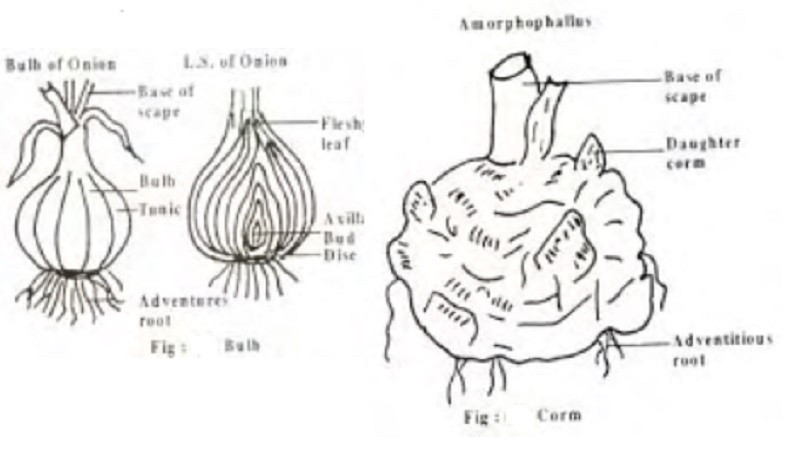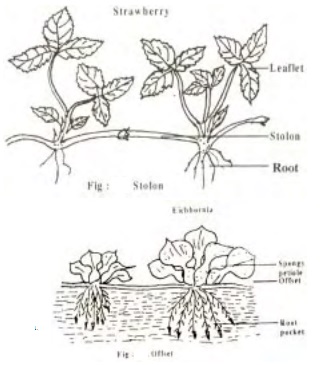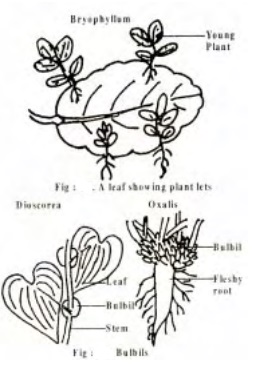Chapter: 11 th 12th std standard Bio Botany plant tree Biology Higher secondary school College Notes
Natural Methods of Vegetative Propagation : Root, Stem, Leaves

Natural Methods of Vegetative Propagation
Vegetative Propagation by Roots
Some modified tuberous roots can be propagated vegetatively, when planted in soil. The buds present on the roots grow as leafy shoots called slips above ground and adventitious roots at their bases. Each slip gives rise to a new plant. eg. Sweet potato, Topioca, yam, Dahlia and Tinospora.
Adventitious buds develop on the ordinary roots of Dalbergia sisoo, Populus, Guava, Murraya sp, etc. which grow to form new plants.
Vegetative Propagation by Stem
In many plants, stem is modified to perform different functions. The modified stems perform three distinct functions (a) perennation, (b) vegetative propagation and (c) storage of food.
Modified stems which help in propagation can be classified into following three categories:
1. Underground
2. Subaerial
3. Aerial.
Propagation by Underground Stem
These plants develop non-green, under ground perennial stems. These store reserve food, propagate vegetatively and are adapted for perennation. They give rise to aerial shoots that grow actively during favourable conditions. On the approach of unfavourable conditions, the aerial shoots die. The underground stems remain dormant during the unfavourable conditions. Once the conditions become favourable, they produce new aerial shoots.
The various types of underground stems are
1. Rhizome, 2. Tuber, 3. Bulb, 4. Corm
Bulb

The stem is shortest and somewhat disc-like and does not contain any food material. Stem is covered by numerous thickened, overlapping leaves or leaf bases (usually called scales). The whole structure takes the form of a bulb. The short and reduced stem bears numberous adventitious roots at its base:
(a) Tunicated bulbs: In this case, the fleshy scales completely surround the reduced stem forming the concentric layers around stem forming the concentric layers around one another. On the outside they are covered by a few dry scales forming a membranous covering, called the tunic. The fleshy scales are bases of the foliage leaves, eg., Onion, etc.
(b) Scaly bulbs: Here, the leaves are small and scale-like and only overlap at the margins. There is also no outer tunic. The scaly bulbs are found in lilies, garlic, etc.
In both the above types, axillary buds frequently develop in the axil of the fleshy scales. These develop into new bulbs or on separation from the parent bulb develop into new plants. They serve both for food storage and vegetative propagation.
Corm
It is more or less a condensed form of rhizome. It is a short, stout, solid and fleshy underground stem growing in the vertical direction. It is more or less rounded in shape or often somewhat flattened from top to bottom. It contains excessive deposits of food material and grows to a considerable size. It bears one or more buds in the axil of scale leaves and some of these buds grow up into aerial flowering shoots and from the base adventitous roots pass into the soil. Food materials get stored in the basal portion and in this way a new corm is formed. eg. Colocasia, Amorphophalus etc.

Propagation by Modified Subaerial Stem
These modifications are found in many herbaceous plants with a thin, delicate and weak stem. In such plants a part of the stem lives under-ground whereas remaining part of the stem is aerial. These plants bear adventitious roots and aerial branches at nodes. Such plants propagate quickly with the help of fragments of special branches.
Subaerial modified stems are of the following types:
1. Stolon, 2. Offset.
Stolons
These develop from underground stems. They grow horizontally outwards and bear nodes and internodes. They resemble the runners except that they are produced just below the surface of the soil, eg., Strawberry, Vallisneria etc.
Offset
These are also known as condensed runners. These originate as short, more or less thickened, horizontal branches in the axil of lower leaves of the main shoots. Unlike a runner, an offset produces a tuft of leaves above and a cluster of roots below. On breaking off from the parent plant, each branch forms an independent plant. eg., Pistia, Eichhornia etc.
Propagation by Leaves
Leaves are not a common means of vegetative propagation in nature. However, Bryophyllum is known for its remarkable ability to reproduce by leaves. In Bryophyllum plantlets develop from the buds present on the marginal notches of the intact leaves. These plantlets become detached and develop into independent plants.
Propagation Through Bulbils
These are spherical multicellular, fleshy buds produced in the axil of foliage leaves in the place of axillary buds. They grow to form new plants, when shed and fall on the ground. eg.
Dioscorea, Oxalis, Pine apple, etc.
Propagation by Turions
These are special type of fleshy buds that develop in aquatic plants. Eg. Potamogeton, Utricularia, etc. for vegetative propagation.
Horticultural importance of Natural vegetative propagation
Agriculturists and horticulturists use various means of natural vegetative propagation explained above for raising crops and garden plants for commercial purposes.
The chief advantage of vegetative propagation is the perpetuation of the desirable features of a selected plant. We are familiar with the fact that potatoes are propagated by whole tubers or their pieces, ginger and banana by the division of rhizomes, Colocasia and Crocus by the pieces of corms, onion and garlic by bulbs, mint and chrysanthemum by suckers and sweet potatoes by the pieces of tuberous roots.
Related Topics